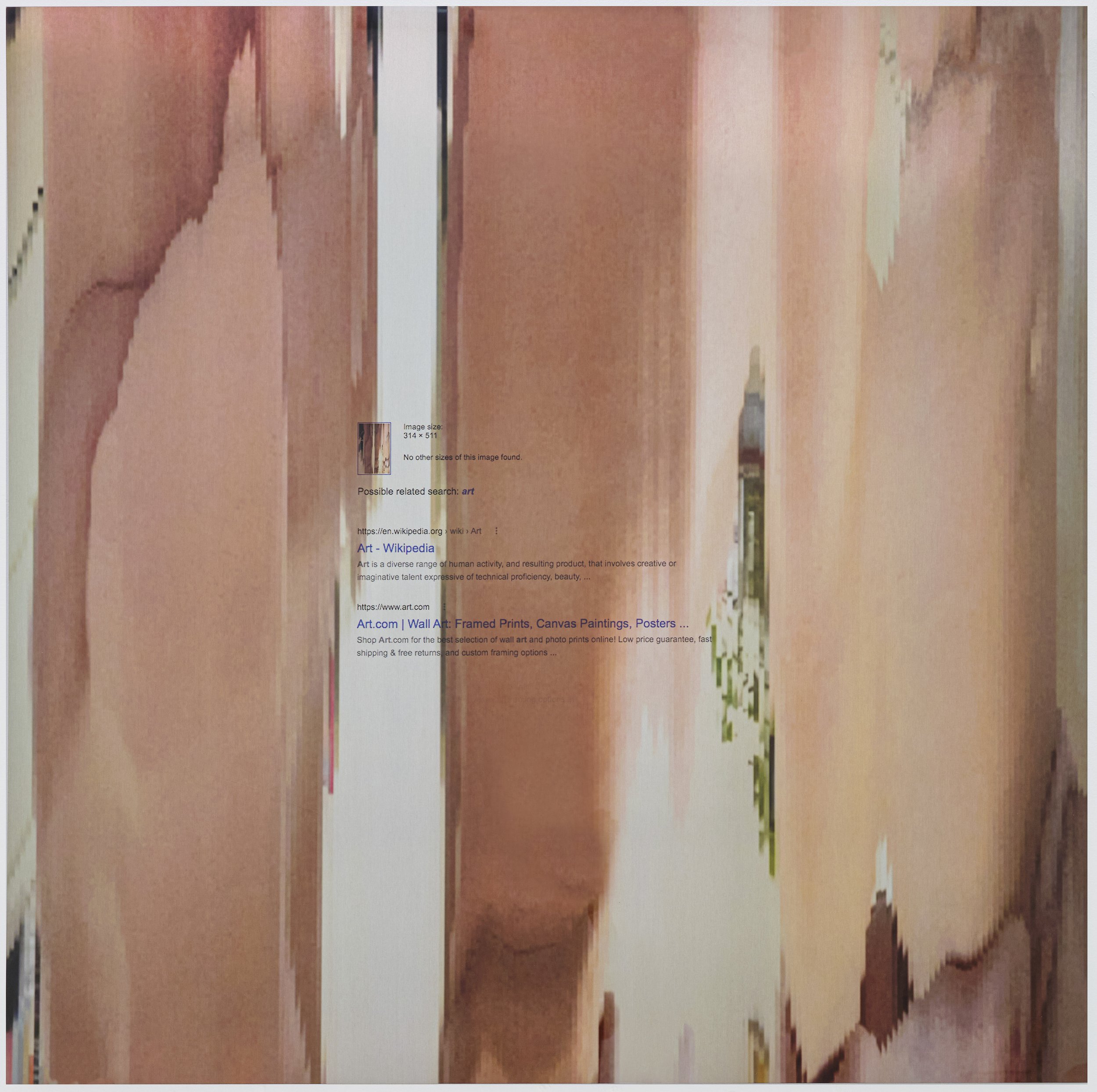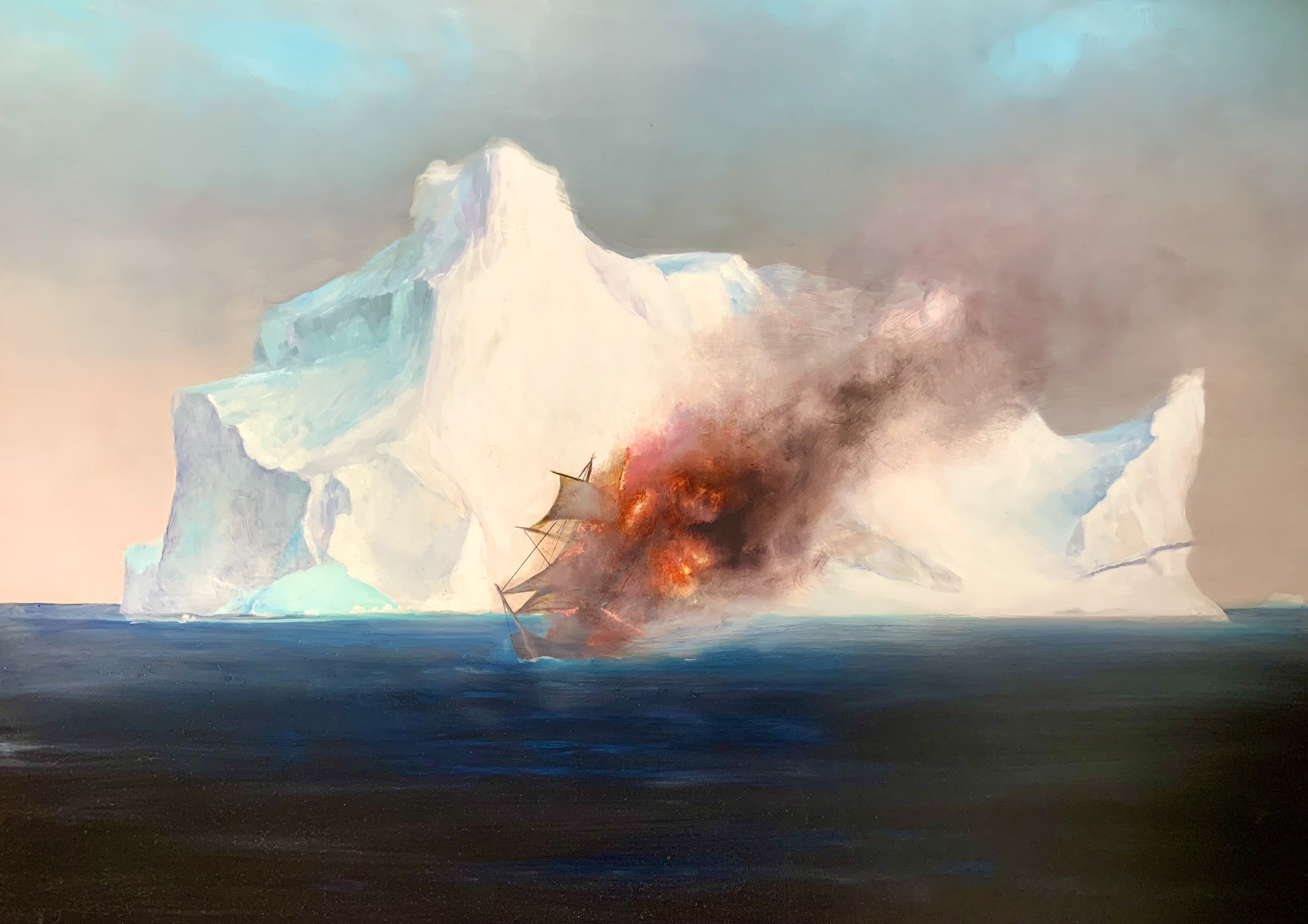The Apocalyptic Sublime
14 - 30 April 2023 - Puzzle Art Garage - Sydney, Australia

WORKS
Michael Prettyman I Remember California, 2022. Oil on canvas. 91.4 × 121.9 cm.
Annabelle McEwen Self Scan’s Possible Related Search: Art, 2022. Dye sublimation print on aluminium. 100 × 100 × 4 cm.
Corey Black Terraforming, 2023. UV prints on aluminium, patinated aluminium rods, cork sheet, silicone, and timber. 91 × 61 × 30 cm.
Corey Black Terraforming, 2023.
Corey Black Terraforming, 2023.
Corey Black Terraforming, 2023.
Michael Prettyman Vio Con Dios 2023. Oil on canvas. 91.4 × 121.9 cm.
Gregory Uzelac Future Relic No. 9, 2021. Pigmented paper. 18 × 14 × 4 cm.
Corey Black Spores, 2022. Plaster, sand, acrylic and PVA. 6 × 4 × 5 cm.
Mungo Howard Full Circle, 2022.
Alternative install.
Corey Black Spores, 2022.
Corey Black Spores, 2022.
Corey Black Spores, 2022.
Gregory Uzelac Golem, 2023. Paper and pigment. 62 × 40 x 2.5 cm.
Corey Black Ergon, 2023. Sandcast and patinated aluminium. 65 × 10 × 6.5 cm.
Taylor Steel castle (static), 2022. Toner, acetate, epoxy resin, polycarbonate and aluminium. 75.5 × 60.5 cm.
Annabelle McEwen Self Scan’s Possible Related Search: Art, 2022. Dye sublimation print on aluminium. 100 × 100 × 4 cm.
Gregory Uzelac Future Relic No. 24, 2021-2023. Dyed plaster. 18 × 17 × 4 cm.
Mungo Howard Full Circle, 2022. Plaster, sand, acrylic and PVA.43 × 43 × 4 cm.

ABOUT
THE APOCALYPTIC SUBLIME
We stand at the precipice of the Anthropocene’s end[1], and yet we are blind to our own self-destruction. So let us time travel. Let us transport ourselves to a space where the beginning and the end live in sacred harmony, where we can earn what our presence means on this planet.
DARLINGS is pleased to present The Apocalyptic Sublime, a presentation of our climate crisis through a mythic, esoteric lens. The gallery is transformed into a ritual space, an atemporal shrine that exists simultaneously before, during, and after "The End." The works within this exhibition generate an aura of reflection and technorganic vibrancy. Gaze and the works gaze back. Drawing from the principle of darshan, or mutual sight, each of these works is presented as a sacred object to experience and communicate with, not simply view[2].
Each of these artists has brought forth esoteric offerings to contemplate cycles of birth and death, evolution and decay. Despite their motionlessness, Corey Black’s creations - blends of natural and machine processes that yield bio-technical bodies - blur the line between organic and inorganic. Annabelle McEwen’s metallic icon holds within it the techno-liturgy of AI-generated existentialism, while Taylor Steel gifts us with a window to a far-off, dream-like refuge from the stygian shrine commemorating self-destruction.
There is alchemy within these walls as well. Gregory Uzelac’s golems are born from cryptic documents and forsaken paper materials, given new form and purpose by both machine and the artist’s hand. Centering this microcosm is Mungo Howard's Full Circle, reminding us of the natural entropy of all things, as well as rebirth from the ashes of our collective and personal endpoints.
This exhibition is one of the world[3], not simply Australia. From afar New York-based artist and scholar of religion Michael Prettyman adorns the space with beautifully tragic landscapes. To minimize , instead of freighting his canvases, DARLINGS has supplanted Prettyman’s paintings with single print editions. The message transcends the medium. Prettyman has set his perfect recreations of classic American landscape paintings ablaze, along with the idyllic, imperialist perception of nature. The fantasy of unchanging natural beauty is shattered. The reality is that we preserve life in classical art, but destroy it in real modernity.
Look down to the floor. As you step, your footprints amongst the charcoal, clay, and coals allude to some great fire - a fire we ourselves caused, but from which we can transform. The world today is over. Tomorrow is a new one. Walk out of this place reinvigorated, revived, and reborn so that we may help our world do so too.
DARLINGS is pleased to present this exhibition in partnership with Puzzle Art Garage, an experimental, nonprofit curatorial space in Sydney, Australia.
[1] MacCormack, Patricia. "All action is art." In The Ahuman Manifesto: Activism for the end of the anthropocene, 67–94. London: Bloomsbury Academic, 2020. Accessed April 4, 2023. http://dx.doi.org.ezproxy.library.sydney.edu.au/10.5040/9781350081130.ch-002.
[2] Vidya Dehejia. Indian Art [London: Phaidon Press, 1997], 137
[3] Maet, Frank. “The Artist as Anthropologist of the Current Globalisation: a View on the Present-Day Cultural Imagination in the Artworks of Xu Bing, Takashi Murakami and Shahzia Sikander.” Critical Arts 30, no. 3 (2016): 307–21. https://doi.org/10.1080/02560046.2016.1205318.

THE ARTISTS
Michael Prettyman (b.1965 in Pensacola, FL, USA) is a contemporary artist and scholar of comparative religion. Prettyman’s practice is concerned with postmodern iterations of classic representational painting as informed by esoteric spiritual practice and study. Prettyman trained in classical drawing, painting, and sculpture at The School of Visual Art and New York Academy of Art and received advanced instruction in thangka painting at the Tsering School of Art in Kathmandu, Nepal. He has studied Tibetan Buddhist meditation and thangka in India, Nepal and American monasteries and holds a Master of Arts in theology from the Harvard Divinity School. Prettyman has exhibited in the US, Hong Kong, Spain, and Kazakhstan, and has permanent mural installations in the American Museum of Natural History, New York Botanical Gardens, Bronx Zoo, and St. John’s Church in New York. Prettyman teaches Religion and the Visual Arts at Hunter College, and lectures widely on creativity, spiritual practice, mysticism and ideas of the divine. IG: @clorofwolves
Corey Black (b. 1997 in Eora/Sydney, NSW, Australia) works across and within images and objects through metals, plastics, and pixels. His work speculates on the potential between materiality, bodies and process. Black recently completed his final year of postgraduate study at the National Art School under the supervision of Hany Armanious and Geoff Kleem, with the aid of the Look Print Standish & Co. Scholarship. Recently, Black participated in the inaugural Cut N Polish Artist Car Boot Sale at Sydney’s Carriageworks, completed 3 months at the British School at Rome residency, resulting in the June Mostra, Italy 2022. Throughout the past five years of study Black has participated in numerous group and two person shows, been involved in the organisation, curatorship and documentation of various exhibitions and undertaken an artist residency at the Corridor Project in Cowra, Australia. IG: @corey_max_black
Mungo Howard (b. 1998 in Eora/Sydney, NSW, Australia) is a multidisciplinary artist whose practice stems from personal encounters with found, cast-off material – broadly encompassed by the topic of ruins. At both the collection and reformation stages of Howard archaeologically-inspired process, traces of decay are registered and reinforced through the utilisation of indexical media. These methods include analogue photography, transfer printmaking and sculptural casting processes. Ultimately, the works reflect an approach to the everyday environment where new value is invested into things formerly overlooked or cast-off. Howard holds a Master of Fine Art from the National Art School. He was awarded the Mark Henry Cain Memorial Travel Scholarship in the United Kingdom in 2019 and has had exhibitions with Tiles:Lewisham and Robin Gibson Gallery. IG: @Mungo_Howard
Annabelle McEwen (b.1997 in Eora/Sydney, NSW, Australia) is an artist working across various printmedia and technological spaces. McEwen’s practice considers how users of digital landscapes achieve agency in an algorithmically curated space. She uses corrupted images of the body and the self as a visual metaphor for the affect of cyber navigation on the individual. McEwen employs mainstream algorithms and artificial intelligence as tools to disrupt images, interfering with the capital-driven codified power of data collection, pattern recognition, and ensuing algorithmically dictated scrolls. She transfers virtual images onto real world objects in an attempt to materialise the digital experience and to speculate on existential futures. McEwen holds a Master of Fine Art degree from The National Art School. IG: @annabelle_mcewen_
Taylor Steel (b. 1998 in Eora/Sydney, NSW, Australia) is an artist whose practice is informed by historic traditions of decay and contemporary material investigations within the field of graphic ontologies. Steel approaches decay and disorder not only as a subject in the field, but as a methodology in her experimental printmaking practice. She received her Master of Fine Arts from the National Art School in Sydney in 2022, where she also completed her Bachelor of Fine Arts in printmaking in 2020. Steel was the recipient of the Bird Holcomb Foundation MFA award and has been recognised for her innovative practice throughout New South Wales. Steel's work is currently housed in the National Art School Collection as well as several private collections in Australia and beyond. IG: @taylor.gov.au
Gregory Uzelac (b.1990 in New York, NY, USA) is an artist, writer, and curator working between New York and Eora/Sydney. A multilingual son of immigrants, Uzelac's work draws inspiration from the cultural hybridisation of migration, mass media, and myth. Uzelac received BA from Northwestern University in 2013, majoring in Cinema and Asian Studies, focusing on postcolonial theory and Subcontinental religion. In 2022 he completed a Master of Fine Arts at Sydney University, where he is currently a researcher in the Studies of Religion department. Uzelac merges esoteric study with the Superflat Theory of artist Takashi Murakami, indiscriminately, bringing together literary, cinematic, religious, and historical elements to produce tales relevant to society now. IG @greguzelac

